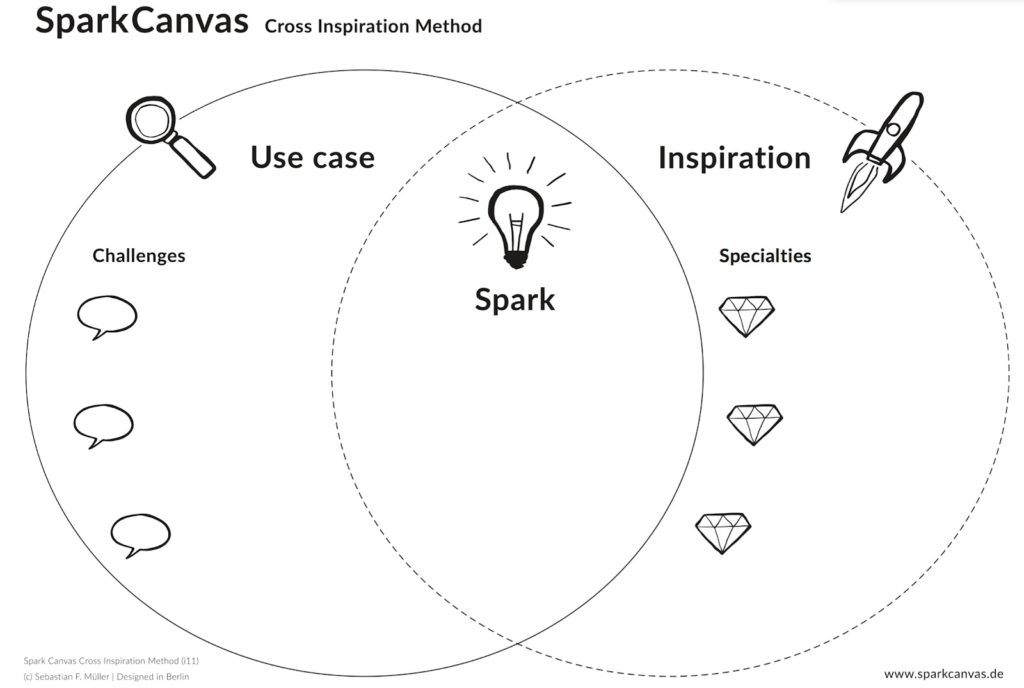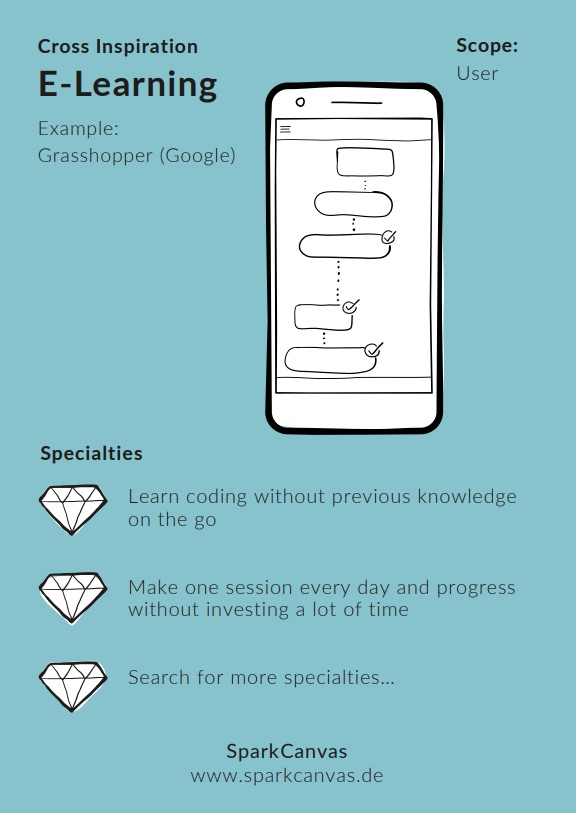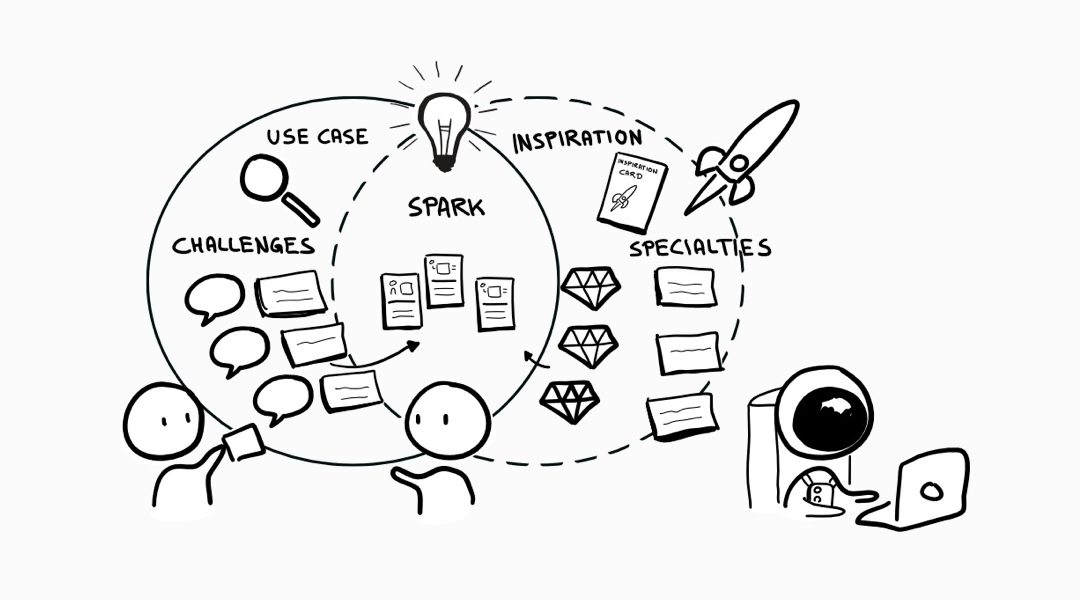Many modern tools are devoted to optimize our working environment. Whether it is to collect, drawing and text with colorful sticky notes or using other creative methods – ideas bubble up, clusters are created and the solutions are ready-to-go. Working together in an innovative way sounds easy and looks good from an outsider perspective, but how does a creative thinking process really work? What is idea generation dependent on and how can we support it without getting caught in the problem?
The experts Sebastian F. Müller and Anastasia Held gave exciting answers to these and many more questions at the 31st meetup of the New Work Berlin Community (German) on May 28th, 2020. They presented the SparkCanvas method and shared insights into a working method that illuminates this creative process.
Sebastian is a designer and lives in the world of IT and Computer Science. After some experience with creative methods and design thinking workshops, he developed SparkCanvas as an ideation method 3 years ago. Since then he has used SparkCanvas successfully in design thinking workshops, design sprints, innovation projects and agile teams.
Anastasia, a full-time product owner for mobile apps at LBBW, has repeatedly applied this method at her workplace and now leads the SparkCanvas meetup with Sebastian.
Idea development made easy – The SparkCanvas method
SparkCanvas is driven to improve customer experience or to solve a user problem. To do this, a challenge is first identified for a customer scenario (use case). For this challenge, inspiration from another context is sought, which can serve as a possible spark for a suitable new solution. SparkCanvas transforms an initial inspiration into a customer benefit and helps to identify what the customer really wants.
The SparkCanvas method uses a 6-step process that can be carried out as a one-day workshop. Use the SparkCanvas website to find all relevant materials: www.sparkcanvas.de.
The six SparkCanvas steps
- Use Case – Context and interaction: What concerns the customers and what bothers them?
- Challenges – What are the challenges in this situation? What should be improved? What is missing?
- Inspiration – Look into a solution from a completely different area and…
- Specialities – … abstract the characteristics.
- Spark – Challenges are combined with inspirations. The aim is to see whether a brilliant idea develops from it and how the speciality can become a solution for the respective challenge.
- Prototype – How can the best ideas be implemented? Ideas are tested in real life.

Example Scenario: Improve social proximity when working from home
To show you the SparkCanvas method, we use the same scenario that was worked during our meetup and walk you through, step-by-step. The use-case is: “improve social proximity when working from home”. This is certainly a hot topic for many at the moment, as the article was written in the time of the COVID-19. For this purpose, a video of an interview with Josef (the customer for our practice scenario) was recorded, which is the starting point for our SparkCanvas process.
His three biggest challenges, which we all can probably understand very well right now, are the following:
There is not much variety during digital meetings. At meetings I am fascinated by the rooms of others. I do not have this experience at virtual meetings.
I miss the spontaneous encounters with other people. A planned coffee is not the same as when you meet by chance and share funny stuff.
I miss my daily commute to work, cycling along the river. Both as a sporting activity and as a time for reflection, during which I can do some thinking or listen to a podcast.
The group work starts with inspiration
Now the exciting and creative part of the SparkCanvas method begins. As groups, the participants go through the three steps Inspiration, Specialities and Spark. In our case, five groups are divided into Zoom Breakout Sessions, which then work together virtually on a SparkCanvas. Sebastian and Anastasia have prepared Miro Boards as digital whiteboards. The method also works quite well with other digital boards, for example, Mural is recommended as an alternative. Logically, the SparkCanvas method also works in real life – analog with post-its and whiteboards.

Example of a SparkCanvas inspiration card
The SparkCanvas board contains some pre-designed inspiration cards. One of them is e-learning: Google Grasshopper is an e-learning service that teaches programming in small steps on the go. For the purpose of inspiration, each group will study a completely different cross inspiration. Intentionally, this has nothing to do with the actual problem. This is a real mind shift for everyone: on a trip to completely different regions of the brain, away from the problem, towards different solutions. So in this example, we briefly research how Grasshopper works, what the special features are and how it is positioned in the market.
The inspiration, for example an e-learning platform, is then used to record its specialties. To make it easier to get started, specialties are already predefined on the inspiration cards of the SparkCanvas boards provided, such as “Do a short exercise every day and get ahead without investing too much time”. During the meetup, the teams also came up with new ideas for specialties, such as “I can connect with other users and build a community”.
Of course, you don’t have to use the ready-made inspiration cards. If one of the participants has another exciting source of inspiration, it can be used just as well. The goal is to abstract some exciting features or cool ideas from other solutions. Ideally, you should forget the use case and the challenges. Hence the tip: don’t have a solution in mind. Have an open attitude towards new solutions from completely different areas.
The ideas ignite: Spark
In the Spark step, the specialties are linked individually with the original challenges by the participants. This step is used to consider, whether a possible idea for a solution can be developed from them. If some kind of combination is found, it is collected with all other sparks on the board.
The three steps inspiration, specialties, and spark are each guided by a facilitator, in this case Sebastian and Anastasia, and then elaborated in the five groups. And in fact, this resulted in very cool and workable ideas. At the end of the meetup, these ideas were presented to the client Josef, who joined the virtual meetup.
Sparks for more social proximity when working from home
We were very happy to do a SparkCanvas exercise with our participants. All five groups were able to show their creativity. To wrap up our example, you can find some of the ideas to improve social proximity in a working-from-home setup here:
- A chatbot, to which I can tell what I am currently working on: It then suggests colleagues to me who are engaged in similar topics. This can also be a picture or a song or whatever comes to mind. Here you can also simply share a funny story from everyday life (storytelling is also practiced).
- Chatroulette with colleagues: I am randomly assigned to a colleague at work and have a common video call for a few minutes.
- A virtual coffee-kitchen room, which is always open: Here colleagues can meet spontaneously and exchange ideas, smalltalk, etc.
- Joint walks with mobile phone and video call: Show and introduce the surroundings, share views of nature. Everyone comes out occasionally and moves.
- Lunch together: Like in the canteen, but by video call.
- We introduce our home office workplace to each other or offer a tour around the apartment to create proximity.
- Virtual meetings in the living room of the colleagues: Everyone who is interested can virtually invite people to their home and then shows their home office at the beginning of a meeting. In the future, all participants in a meeting will wear VR glasses and virtually sit together in the same room.
SparkCanvas – an ideation tool for the future of work
In the modern working world, there are constantly changing conditions and ambiguous situations. The classic approach simply doesn’t work anymore. New ideas and solutions are needed all the time. This is where the SparkCanvas method can offer great and creative support. It helps you to think outside the box and promotes the idea generation process in the team. By focusing on well-functioning and successful solutions in the inspiration phase, a positive working atmosphere is created and the joy of problem-solving increases. This became very clear in the New Work Berlin meets SparkCanvas meetup. The igniting spark was evident in all groups. In a real working environment, the prototype phase can begin right after, which enables a first implementation.
We recommend this method to interested parties and look forward to receiving feedback about your experiences.
Our guest authors

Jens Hündling – picture by studioafraz.com
Jens Hündling is a freelance trainer and coach for digital transformation and new work. As a former IT executive, he prefers to communicate with people rather than machines. Jens is passionate about developing teams and organizations. Especially with East Frisian humor. More about him at https://dr-huendling.de

Heidi Dommaschke
Heidi Dommaschke accompanies people and organizations in change as trainer, mediator and coach. In addition to inner work, resilience and resource development, she is particularly interested in the further development of communication and conflict competence. In doing so, she is concerned with the question of how we want to live and work, and how we can actively shape the world around us. https://www.hundred-ways.com


